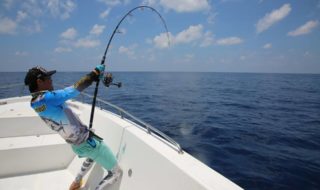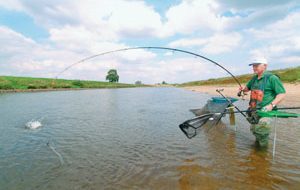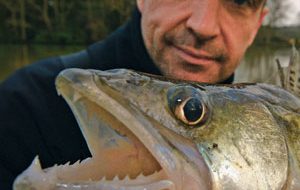| South Clarence. |
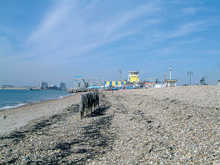 |
IF it’s a mixed bag you’re after, then these
 |
marks will be right up your street. You can bag anything from huge plaice to black bream and garfish here.
Portsmouth, Hampshire, is known the world over as the home of the British Navy. This naval heritage can be traced back to at least 286AD when a Roman sea captain by the name of Carausius was sent to deal with increasing piracy in the area. Ironically he became a master pirate himself and Rome had to send a fleet of ships to quell the rebellion.
There are two harbours, Portsmouth and Langstone, and an extensive seafront with many and varied fishing stations. The best access to the seafront is the M275. Follow the signs to Cross Channel Ferries from junction 12 of the M27, then look for Southsea and Seafront. Don’t be afraid to take the family, there are masses of attractions along the seafront!
The West Winner
This is no longer the distinctive mark it once was due to coastal erosion, but there are still plenty of features to look out for. Head for the extreme east of Southsea Beach and turn into Melville Road signposted Hayling Ferry and Marina. There is a car park about a kilometre down the road on the right. The West Winner is behind the MOD installations. It is a sandy bank well known for its huge plaice and flounder. One angler weighed in three plaice for 11lb at Allan’s Marine a few years back. Bass and bream are common through the summer months. There is also the Bunny Pipe, which is weed covered and very slippery so caution is required here. Also there is the old outfall pier. Bass, mackerel, bream and garfish are found through the summer months. Main baits are ragworm, mackerel and after a blow, local slipper limpets.
St George’s Road
You’ll find this beside the par three golf course, one kilometre east of South Parade Pier. You can park for free along the side of the golf course. It’s probably the best-known spring plaice mark along the south coast and fishes well from low water up. Ragworm fished at distance can produce flatties up to 4lb. In the summer, bass, pout and gurnard will show. A good number of cod and whiting will be caught from October to January. Smoothhound have been on the increase on summer evenings, falling mostly to peeler crab baits. Beware the board-sailor areas, which are marked with large buoys.
The Blocks
These are World War II anti-submarine defences and can be seen clearly at low water as huge concrete blocks, and signposted with markers when submerged. They are situated about 500 metres to the east of the pier. Fishing either side of the blocks will bring mixed bags of pollack, wrasse and bream in the summer with the odd codling and whiting in the colder months. Large plaice can be taken here in March and April. Bass respond after a ‘blow’ to slipper limpets. There is ample parking along the entire seafront but this can be expensive for a whole day through the summer. Red mullet are on the increase along Southsea seafront with a 1lb 13oz 8dr fish taken recently from nearby South Parade Pier.
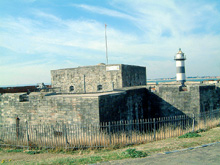 |
Southsea Castle
This ancient monument is west of the pier and near to the war museum. It is easily found along the seafront because of the display tanks and troop carriers along the esplanade. Fishing is mainly from low water up from the harbour wall. There’s no need for distance casting here, with bass, sole, bream and eel being caught close in throughout the summer. Smoothhound and dogfish also show during the summer months. Beware the slippery surfaces because the water is very deep near to the shipping channel. The best baits are peeler crab for the bass, eel and smoothhound, with worm baits taking the sole and bream.
Clarence Pier Beach
This is at the western end of Southsea seafront and the pier is adjacent to the amusement arcades. A good low-water mark is beside the brick Rowing Club building 400 metres to the east of the Hovercraft Port. Some excellent sole are caught here from August until November. A low-water start about 8pm is a good guide, so make sure you consult your tide book first and pick the best ones. Eel, bass and gurnard are also caught here, but they tend to fall for crab or fish baits. A number of red mullet have been reported throughout 2003. Ragworm and peeler crab are effective. Remember to keep hooks to size 2 or 4 for the sole.
Victoria Pier
This is the ironwork pier in front of Portsmouth Harbour mouth. It is found by following signs to ‘Old Portsmouth’ and parking in front of the ancient walls. Walk through the archway to this free and very prolific pier. Now here’s a ‘trick’: since the shipping channel is very narrow, mackerel and garfish shoals concentrate here for the flood run, which begins about three and a half hours before high water. If a Cross Channel Ferry comes through at this time, the massive props will take their toll of ‘mackies’ and ‘gars’. The result is chopped fish for the bass. Put a chunk of mackerel or gar on a size 4/0 and belt it out into the wash of the ferry – it does work. Around the ironwork there are plenty of pollack, wrasse, bream and garfish. Spotted ray are caught from the channel on fresh mackerel.
Tackle Shops
Lock Stock And Tackle, 337 Copnor Road, Portsmouth, tel: (023) 9264 2200.
Lock Stock And Tackle, 26 Elm Grove, Southsea, tel: (023) 9281 2478.
Allan’s Marine, 143 Twyford Ave, Portsmouth, tel: (023) 9267 1833.
TF Top Tip
Try tipping your baits off with a chunk of sandeel or mackerel; the extra fishy scent could help attract a gurnard or two.
When a ferry cuts across the shipping channel, it’s a good idea to cast a chunk of mackerel or garfish into the wash for a bass.


